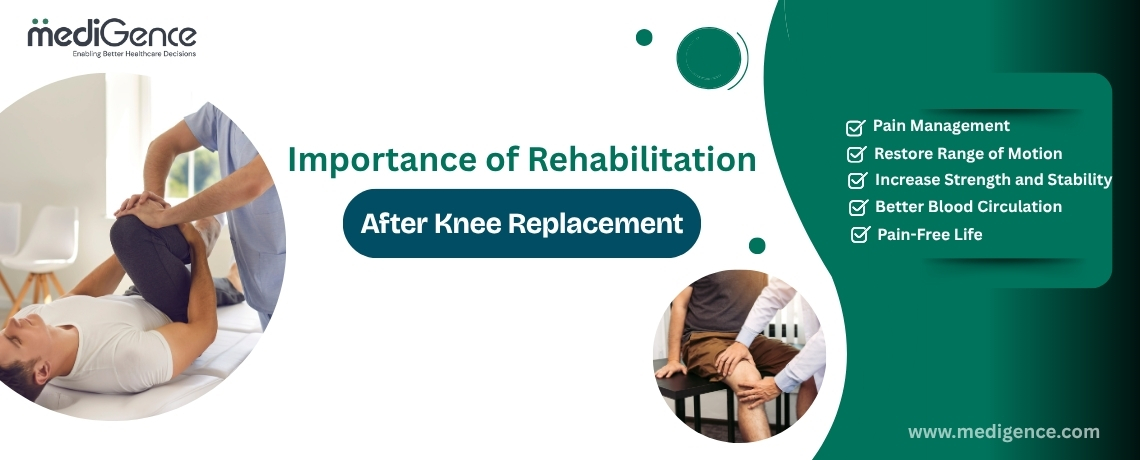
Knee replacement surgery or knee arthroplasty is one of the practical choices that can be made by patients suffering from severe knee arthritis, injury, or chronic pain. It is essential to understand that the success of knee replacement surgery depends on both the surgery and appropriate rehabilitation to ensure long-term mobility, pain relief, and functional improvements.
MediRehab (A chain of rehabilitation centers in India that is part of MediGence) focuses on recovering patients from musculoskeletal, neurological, and post-surgical conditions. Using advanced physical therapy programs, individualised exercise plans, and state-of-the-art rehabilitation techniques, MediRehab provides optimal recovery and life quality improvement.
This blog discusses the role of rehabilitation after knee replacement, including the phases of rehabilitation, the benefits of rehabilitation, and the associated success rates.
What Is Knee Replacement Surgery?
A knee replacement surgery involves removing damaged cartilage and bone from the knee joint and replacing them with artificial materials to relieve pain and improve the function of the knee joint, allowing people to return to their active lifestyles. Rarely would the expected outcomes be achieved without rehabilitation.
Rehabilitation Requirement After Joint Replacement Surgery
Joint replacement surgeons recommend post-operative exercises, therapy, and activities to aid in joint rehabilitation after surgery. Joint Replacement Rehabilitation: To ensure smooth surgery and recovery.
Rapid Healing
Previous activities and exercises can help speed up recovery. They decrease pain and increase proper movement and functioning. All the exercises must bear a concept from joint replacement surgeons.
Alleviation of Pain
Various physical therapies and techniques would be applied after rehabilitation post joint replacement, which would serve to alleviate pain. These also guarantee smooth and functional movement of the skeletal system.
Prevention of Further Complexities
Strengthening exercises and rehabilitation programs after joint replacement work toward boosting muscle recovery, as this strength is needed for these muscles to stabilise joint function.
Some exercises include:
- Knee extension: An exercise that emphasises joint movement and strength function for recovery in all knee surgical procedures.
- Straight-leg raises: Strengthening exercises for the muscles around the hip are an essential step in strengthening those closest to the knee.
- Hip abduction: Building muscle in the gluteal and surrounding muscles is beneficial with this exercise. Strengthens the ankles and knees, improving control of the lower body.

Get Free Online Consultation with Expert
Phases of Rehabilitation After Total Knee Replacement
Acute Postoperative Phase (Day 0-2 weeks)
- In-hospital recovery: Early gentle movement within 24 hours to avoid knee joint stiffness.
- Pain Control: Medications, ice, and elevation for swelling control.
- Immediate Mobilization: Walking with the support of a walker or crutches to prevent clot development.
- Start of Physical Therapy: Gentle initial exercises such as ankle pumps and knee extensions.
Early Recovery Phase (2 to 6 Weeks)
- Home Recovery: Progressing from walker to cane and independent walking at home.
- Range of Motion Exercises: Stretching and bending exercises focus on improving knee flexibility.
- Strengthening Exercises: Leg raises, seated knee bends with resistance, or mild resistance training.
- Pain and Swelling Control: Continuous use of icing and elevation techniques.
Intermediate Rehabilitation (6 to 12 weeks)
- Improved Weight-Bearing: Gradually, the patient starts to bear more weight on the operated knee.
- Advanced Strength Training: Squats, step-ups, and resistance exercises.
- Balance and Coordination: Standing on one leg, side leg raises, and controlled movements.
- Activities that cause less strain yet sustain cardiovascular fitness include cycling, swimming, and other in-between activities.
Long-Term Recovery and Maintenance (3 to 6 months)
- Return to Daily Living: Gradually return to work, sports, and recreational activities.
- Ongoing Strengthening: Involved physical therapy for stable and functional knees.
- Preventive Measures: Avoid activities that could cause high stress to the knee.
- Regular Follow-ups: Schedule periodic visits with your doctor to monitor your knee health.
Benefits
- With accelerated recovery, structured rehabs heal faster and restore mobility more quickly.
- Lower medication dosage: Pain is managed through physiotherapy exercises.
- Strengthened muscle power: Strengthens the quadriceps, hamstrings, and surrounding muscles.
- Better joint performance: Promotes improved knee movement with increased flexibility.
- Less likely to develop complications: Lower chance of blood clots, infection, and stiffness.
- Greater freedom: The person will be able to engage in activities independently.
Success Rates
- Pain relief: Around 90% will have considerable pain relief.
- Mobility: Approximately 85% of individuals will regain normal movement and activity levels.
- Surgical success: 95% of knee replacements will last 10-15 years with a good rehab program.
- Return to activity: About 70-80% of people can return to recreational and low-impact sports within 1 year.
Strategies for Successful Rehabilitation Following Knee Replacement
- Complete Your Physical Therapy: Adhere to your recommended exercise and therapist guidelines for rehabilitative purposes.
- Stay Active, but Practice Caution: Gradually increasing activity should help reduce the stress on your knee.
- Nutrition is essential in the healing of tissues and the recovery process.
- Use of Assistive Devices: Walking aids help maintain balance and protect the knees.
- Recognizing Complications After Surgery: Signs that could indicate infections, swelling, or sensations that require the attention of a physician.

Get Free Online Consultation with Expert
Conclusion
Rehabilitational post-operative care after knee replacement surgery constitutes an integral segment. An exhaustive, well-structured protocol would facilitate mobility and strength development while preventing complications, thereby achieving a long-term functional status of the joint. There are various plans for rehabilitation exercises with lifestyle adjustments that bring up the ability to function independently on a pain-free basis and lead an active life. If you or your loved one is preparing for knee surgery, a good rehabilitation program will significantly increase the success of the operation, thereby decreasing recovery time. To learn more about these plans and services, please contact MediRehab (Part of MediGence).



